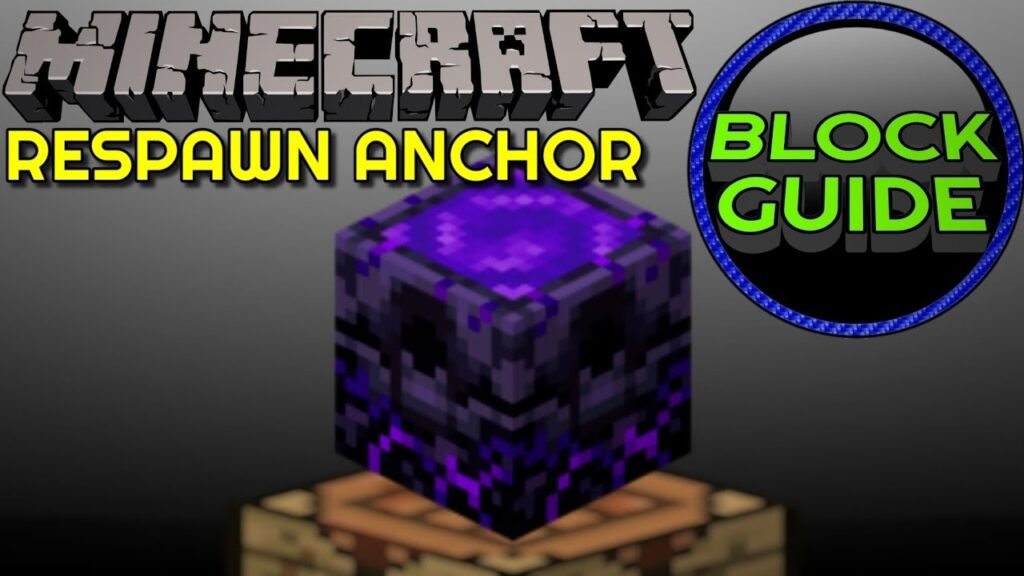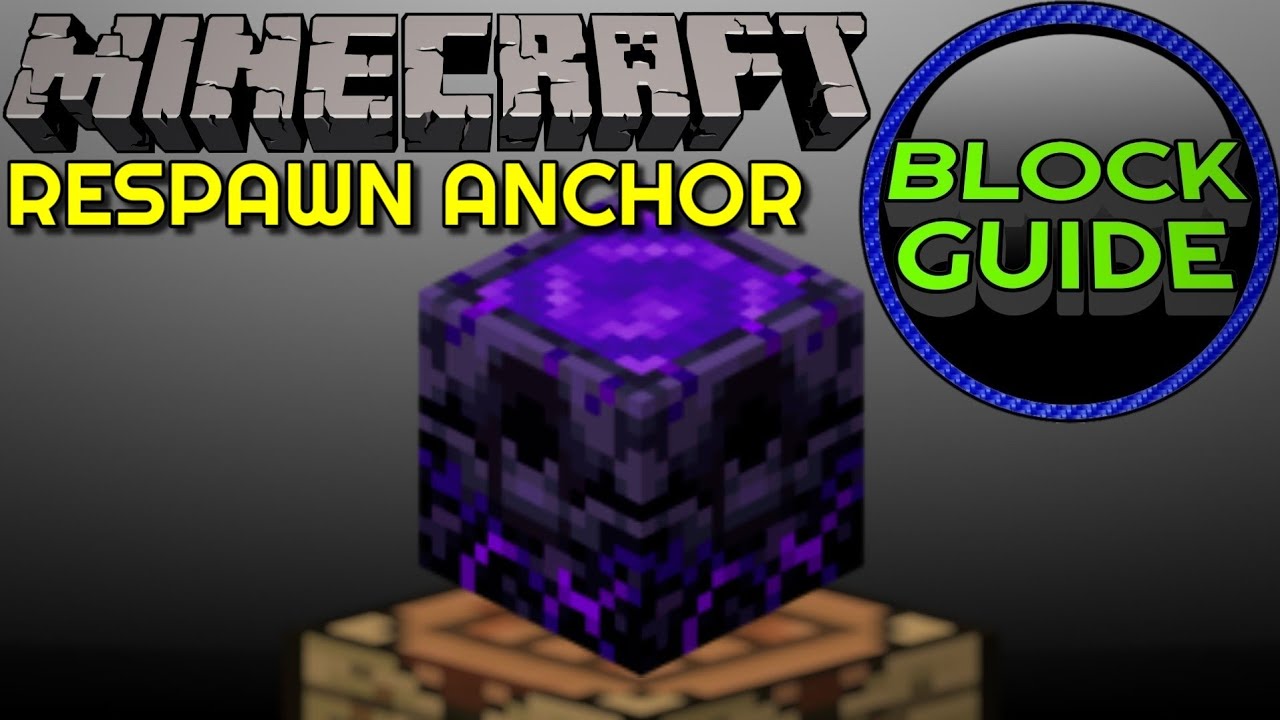
What is a Respawn Anchor? A Comprehensive Guide to Minecraft’s Nether Savior
The Nether, a fiery and dangerous dimension in Minecraft, is notoriously unforgiving. Death lurks around every corner, from lava pools to ghast attacks. Traditionally, dying in the Nether meant a respawn back in the Overworld, often a frustrating setback. But fear not, intrepid adventurers! The respawn anchor arrives as a beacon of hope, allowing players to set a respawn point within the Nether itself. This guide delves into everything you need to know about the respawn anchor, from crafting and charging it to its limitations and strategic uses.
Understanding the Respawn Anchor
The respawn anchor is a block introduced in the Nether Update (1.16) that allows players to respawn in the Nether. Without it, dying in the Nether sends you back to your spawn point in the Overworld, which can be incredibly inconvenient, especially if you’re far from a portal or working on a complex Nether base. The respawn anchor effectively acts as a portable, Nether-based bed (though it doesn’t set the time like a bed does).
Crafting the Respawn Anchor
Crafting a respawn anchor requires some exploration and resource gathering in the Nether. Here’s what you’ll need:
- Crying Obsidian (6): Crying Obsidian is found in ruined portals and can be bartered from Piglins. It’s distinguished by its purple tears.
- Glowstone (3): Glowstone is found in the Nether, typically hanging from the ceilings of caves and tunnels.
Once you have these materials, place them in a crafting table like this:
- Top Row: Crying Obsidian, Crying Obsidian, Crying Obsidian
- Middle Row: Crying Obsidian, Glowstone, Crying Obsidian
- Bottom Row: Crying Obsidian, Crying Obsidian, Crying Obsidian
This will create a respawn anchor. Now, let’s learn how to use it.
Charging the Respawn Anchor
Simply placing the respawn anchor isn’t enough to make it functional. It needs to be charged using glowstone blocks. Each respawn anchor can hold up to four charges. To charge it, interact with the respawn anchor while holding glowstone. Each glowstone used will add one charge, and the block’s appearance will change to reflect the number of charges.
How to Charge
- Place the respawn anchor in a safe location in the Nether.
- Hold glowstone in your hand.
- Right-click (or use the interact button) on the respawn anchor.
- Repeat until the respawn anchor is fully charged (glowing brightly).
Using the Respawn Anchor
Once the respawn anchor is charged, you can set it as your respawn point. Simply interact with the charged respawn anchor. A message will appear on your screen confirming that your respawn point has been set. Now, if you die in the Nether, you’ll respawn near the respawn anchor.
Important Considerations
- Charges are Consumed: Each time you respawn at a respawn anchor, it consumes one charge. Make sure to keep it charged, or you’ll be sent back to your Overworld spawn point.
- No Bed Equivalent: Unlike beds in the Overworld, the respawn anchor does not change the time of day.
- Placement Matters: Choose a safe and well-lit location for your respawn anchor to avoid immediately dying upon respawn.
- Explosions: Trying to use a respawn anchor in the Overworld or End will cause it to explode with the force of a charged creeper, potentially destroying nearby blocks. This is a crucial detail to remember!
Strategic Uses of the Respawn Anchor
The respawn anchor opens up a variety of strategic possibilities for Nether exploration and base building:
- Nether Base: Establish a permanent base in the Nether without the constant fear of losing progress upon death.
- Resource Gathering: Explore dangerous areas of the Nether for resources like ancient debris and netherite without worrying about the long trek back from the Overworld.
- Nether Travel: Create multiple respawn anchors at strategic locations to facilitate faster travel across the Nether. [See also: Nether Portal Guide]
- Avoiding Overworld Spawn Issues: If your Overworld spawn point is inconvenient or unsafe, the respawn anchor provides a reliable alternative for Nether-based gameplay.
Troubleshooting Common Issues
Here are some common issues players encounter with the respawn anchor and how to resolve them:
- Respawning in the Overworld: This usually happens because the respawn anchor is out of charges. Recharge it with glowstone. Also, ensure you’ve actually interacted with the charged anchor to set your respawn point.
- Exploding Respawn Anchor: The respawn anchor will explode if used in the Overworld or End. It’s designed exclusively for the Nether.
- Difficulty Charging: Make sure you’re using glowstone to charge the respawn anchor. Other light sources won’t work.
- Anchor Not Working After Death: Double-check that the respawn anchor is placed in the Nether. If it’s in the Overworld or End, it won’t function.
The Future of Nether Exploration
The respawn anchor has fundamentally changed how players approach the Nether. It has made the dimension significantly more accessible and less punishing, encouraging exploration and base building. As Minecraft continues to evolve, the respawn anchor remains a vital tool for any serious Nether adventurer. Mastering its use is essential for thriving in this challenging environment.
The introduction of the respawn anchor was a game-changer, mitigating the frustration of dying far from a Nether portal. Before its implementation, the arduous journey back from the Overworld after each death was a significant deterrent to extensive Nether exploration. Now, with a strategically placed and charged respawn anchor, players can confidently delve into the depths of the Nether, knowing that a quick return is always within reach. This has led to the creation of elaborate Nether bases, efficient resource farms, and a greater willingness to tackle even the most perilous challenges the dimension has to offer. The respawn anchor is more than just a convenience; it’s an enabler, empowering players to fully embrace the Nether experience.
Beyond its practical benefits, the respawn anchor also adds a layer of strategic depth to Minecraft gameplay. Players must carefully consider the placement of their respawn anchors, taking into account factors such as safety, accessibility, and proximity to key resources. The need to constantly replenish the anchor’s charges with glowstone encourages players to explore the Nether’s caves and tunnels, further incentivizing resource gathering. Moreover, the respawn anchor’s explosive potential in the Overworld serves as a constant reminder of the dangers of the Nether and the importance of respecting its unique properties. In essence, the respawn anchor is a multifaceted tool that enhances both the accessibility and the complexity of the Nether dimension.
In conclusion, the respawn anchor is an indispensable item for any Minecraft player seeking to conquer the Nether. Its ability to set a respawn point within the fiery dimension eliminates the frustration of long journeys back from the Overworld, enabling players to explore, build, and thrive in this challenging environment. By understanding its crafting requirements, charging mechanism, and strategic uses, you can unlock the full potential of the respawn anchor and embark on countless adventures in the Nether. So, gather your crying obsidian and glowstone, craft a respawn anchor, and prepare to conquer the Nether like never before!

